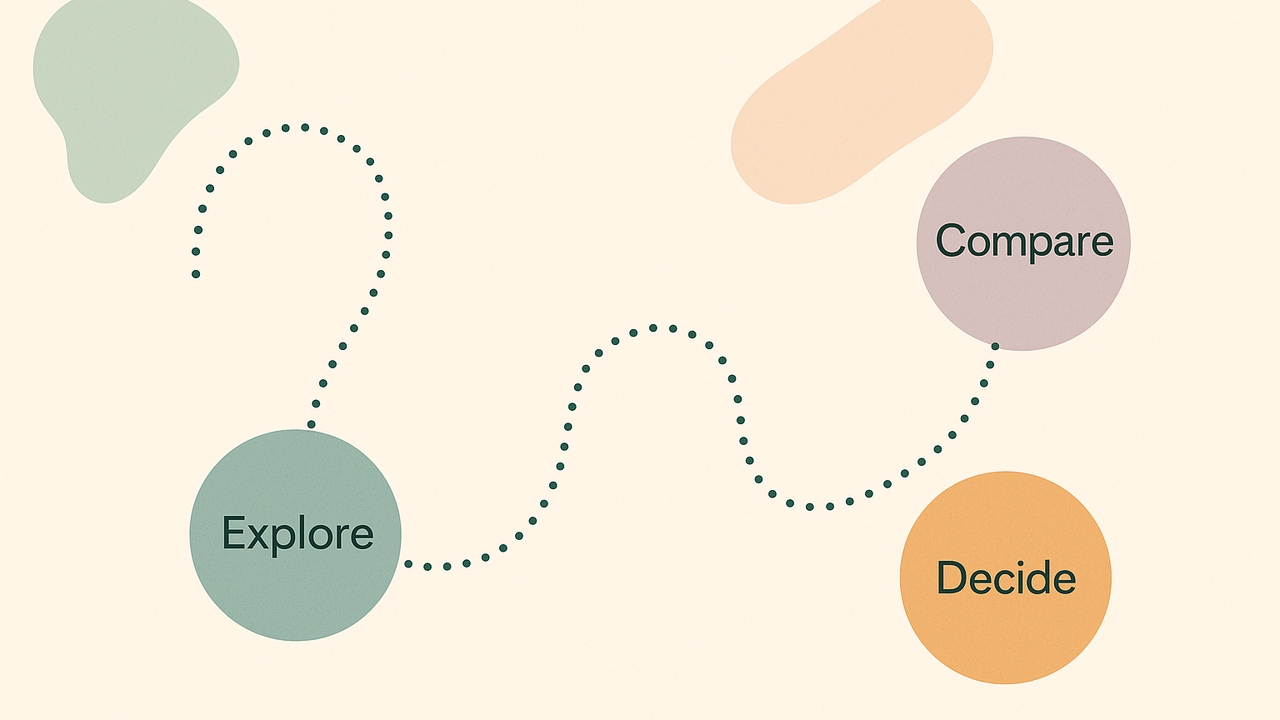
A practical Customer Journey Map template
Built from real sense-making behaviour, not funnels. Mapping intent instead of stages gets closer to reality.
Most customer journey maps assume progress happens in a straight line. Awareness, consideration, purchase, advocacy. A neat staircase. A funnel. A tidy diagram that suggests clarity.
But the real movement happens earlier: in a half-heard question at 9pm, in browser tabs flicked shut, in a coffee mug left half-empty when they realise they’re still unsure.
People go in circles. They return to information they’ve already seen. They pause. They compare. They ask others.
If you design for a neat, linear journey, you are designing for fiction.
Mapping intent instead of stages gets closer to reality.
Why Search Behaviour is a better starting point
When someone searches, they reveal something about what they’re trying to work out. Not who they are. Not a segment. Not a persona. A moment of trying:
- “How does this work?”
- “Is there another way?”
- “Is it worth it?”
- “What am I missing?”
These are small signals of movement.
When gathered over time, patterns emerge.
Search behaviour tells us:
- How people describe their own problems
- Where they hesitate
- What keeps showing up in the decision
- When interest deepens and when it drops
This gives us something better than stages. It gives us the texture of real thinking.
People are not progressing through steps. They are moving through questions.
So we map intent zones, not stages.
Five intent zones we see across most industries
These zones don’t represent steps. People move between them freely, sometimes more than once.
| Intent Zone | What is happening | What to look for (signals) |
|---|---|---|
| Finding Language | Someone is still trying to say what the problem is. | Broad or vague searches. “What is…” / “How to fix…” |
| Understanding Options | They’re collecting ways their problem can be approached. | Reading explainers, guides, “types of…” queries. |
| Testing Fit | The question shifts to whether this solution is for them. | Case studies, reviews, stories from “people like me.” |
| Reducing Risk | The emotional weight of the decision appears. | Pricing comparisons, reassurance seeking, trial requests. |
| Confirming Value | After adopting the solution, the user checks if it holds up. | Onboarding friction, early support questions, referrals. |
Movement between zones isn’t sequential. It is fluid.
Someone might know exactly what the problem is, jump straight into Testing Fit, then go backwards to Understanding Options when they hit doubt. That movement is normal.
This is why static journey diagrams fall apart. They assume confidence increases over time. In practice, confidence fluctuates.
When marketing teams understand this, they stop asking:
“How do we push people along?”
And start asking:
“What clarity do they need at this moment in their thinking?”
That is where the work happens.
How to map these Zones using real signals
We don’t guess which zone people are in when we can observe.
Use the signals already available:
1) Search Console performance reports
Shows language patterns, refinements, recurring questions.
Look for the queries that happen before your branded searches appear.
2) GA4 Navigation Paths
- Where do people backtrack?
- Where do they pause?
- Where do they return?
Ask your team: 'Which page had the most return visits last month? What queries were users still asking at that point?'
This strengthens the operational tie-in.
3) On-Site / Internal search reports
These are the moments where clarity broke.
Someone tried to solve the ambiguity themselves.
4) Support and Sales Questions
When the same question repeats, it’s not just a messaging issue. It’s a decision-making friction.
5) Community, Forums, Social Conversations
People reveal how they explain a product when no brand is listening.
These signals tell you what matters, what confuses, and what reassures.
A simple map you can use with your team
The goal is not to map everything. The goal is to map what actually affects progress. When we map a journey from search behaviour, we are not trying to draw a perfect path. We are tracing patterns of attention. These patterns tend to cluster into a few recurring zones, different kinds of moments people move through.
You will see some version of these five zones in almost every market.
| Customer Intent Zone | What the user needs here | What not to do | Useful content / experience here |
|---|---|---|---|
| Finding Language | Clear definitions and grounding | Brand storytelling | Short explainers, glossaries, “what this means” |
| Understanding Options | A sense of the landscape | Over-optimising for your product | Comparison frameworks, methods, examples |
| Testing Fit | Relatability, relevance | Generic “benefits” | Case studies, walkthroughs, real stories |
| Reducing Risk | Reassurance that cost/effort is justified | Hard selling | Pricing clarity, timelines, onboarding previews |
| Confirming Value | Support in early moments | Leaving them to figure things out | Guides, templates, accessible help, check-ins |
This map guides customer experience development:
- What to improve first.
- What to write.
- What to remove.
It aligns product, content, sales, and operations around the same understanding of need.
Why is matter for business Growth + Operations
Many teams try to grow by adding more:
- More campaigns.
- More channels.
- More content.
- More messaging.
But sustainable growth comes from addressing friction.
"We’ve never spent more on advertising. It’s never done less for us." (Andrew Tindall, The Drum September 2025)
When you know which zone someone is in, you know:
- The kind of problem they are trying to solve
- The emotional weight of the decision
- The level of clarity they have
- The type of reassurance that helps
Growth becomes alignment, not volume.
A major global study found that 84% of purchases stem from a brand the buyer was already biased toward before active consideration began. This suggests that the early zones of intent ("Finding Language" / "Understanding Options") play a role far earlier than many teams assume. (WPP Media & Saïd Business School, Oxford University Marketing Faculty, October 2025)
Closing thoughts
This framework works across various industry sectors, but the weighting of each zone shifts.
For example:
- In B2B, "Reducing Risk" often dominates because decisions involve budgets, reputation, and accountability.
- In consumer categories, "Finding Language" and "Testing Fit" tend to repeat more often because identity and taste play larger roles.
- In local services, "Confirming Value" matters most because word of mouth and lived experience drive adoption.
- In Health & Wellbeing, "Understanding Options" zone is emotional as much as functional. The question is often “Will this work for me?”, signalling identity and trust, not just features.
- In Marketplace platforms, "Testing Fit" and "Understanding Options" zones blend heavily. People experiment as much with the ecosystem (supply side, trust among users) as with the service itself.
- In Finance, "Reducing Risk" is heightened because the stakes are personal, high-impact and often irreversible.
- In Public & Non-profit, "Finding Language" and "Confirming Value" can be slower, as alignment with personal values and transparency are crucial.
Most teams want clarity. A clean diagram. A labelled path. But real understanding comes from watching how people try and looking at the data.
The pauses. The comparisons.
The moment their search changes shape.
When we design for those moments, we make things easier to choose, easier to use, and easier to stay with.
Not because we guided someone through a funnel. But because we supported how decisions actually happen.


